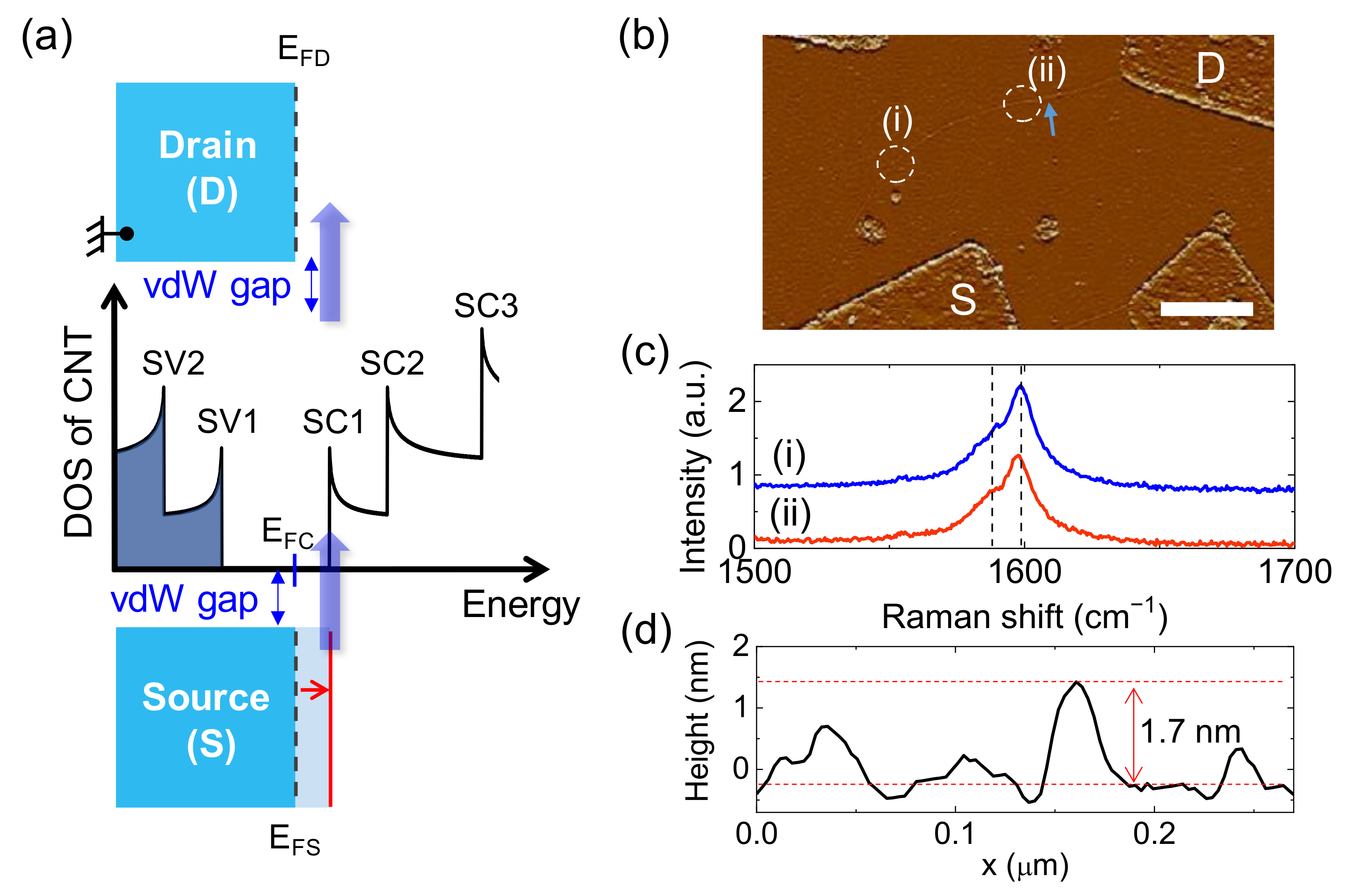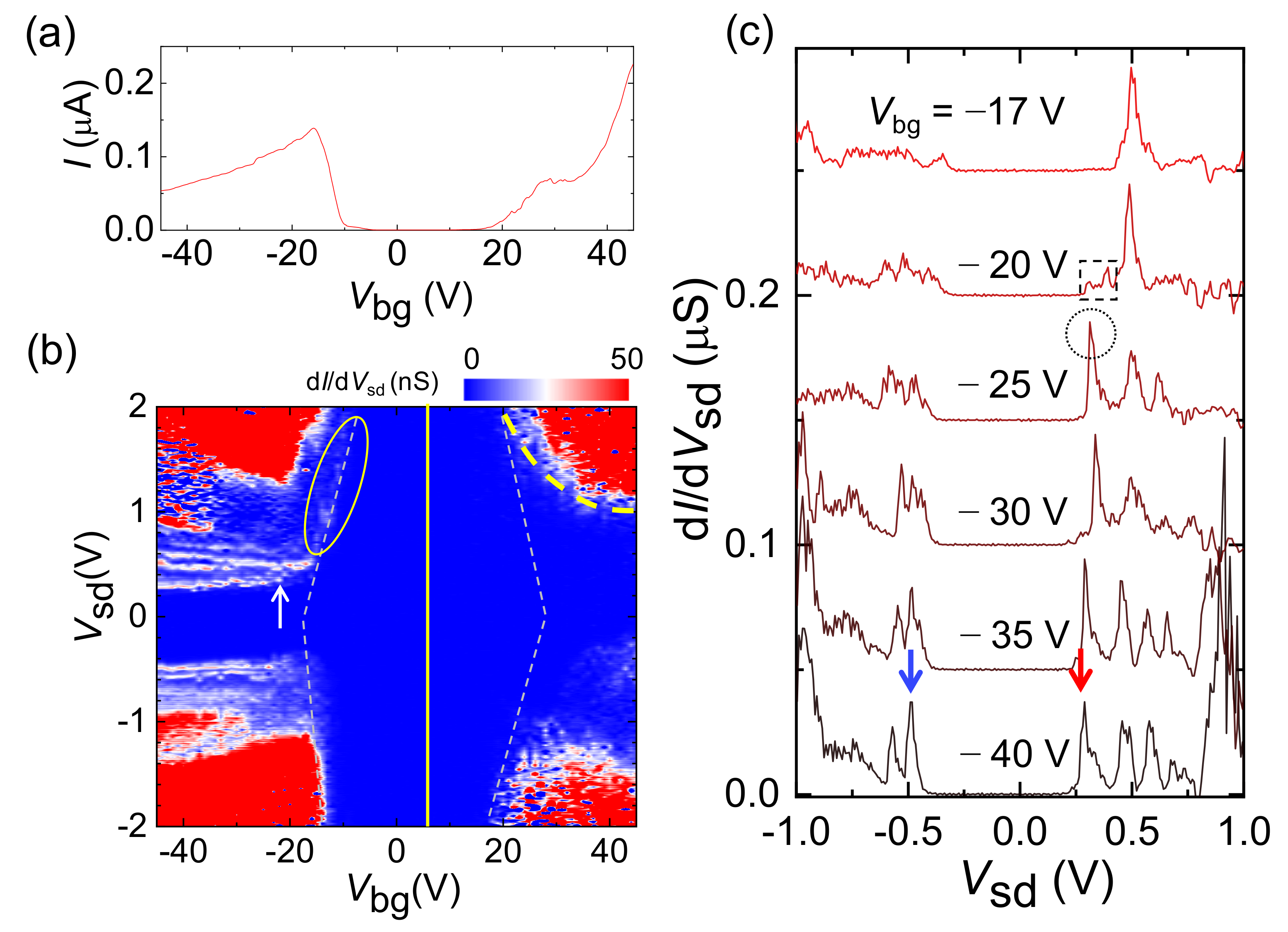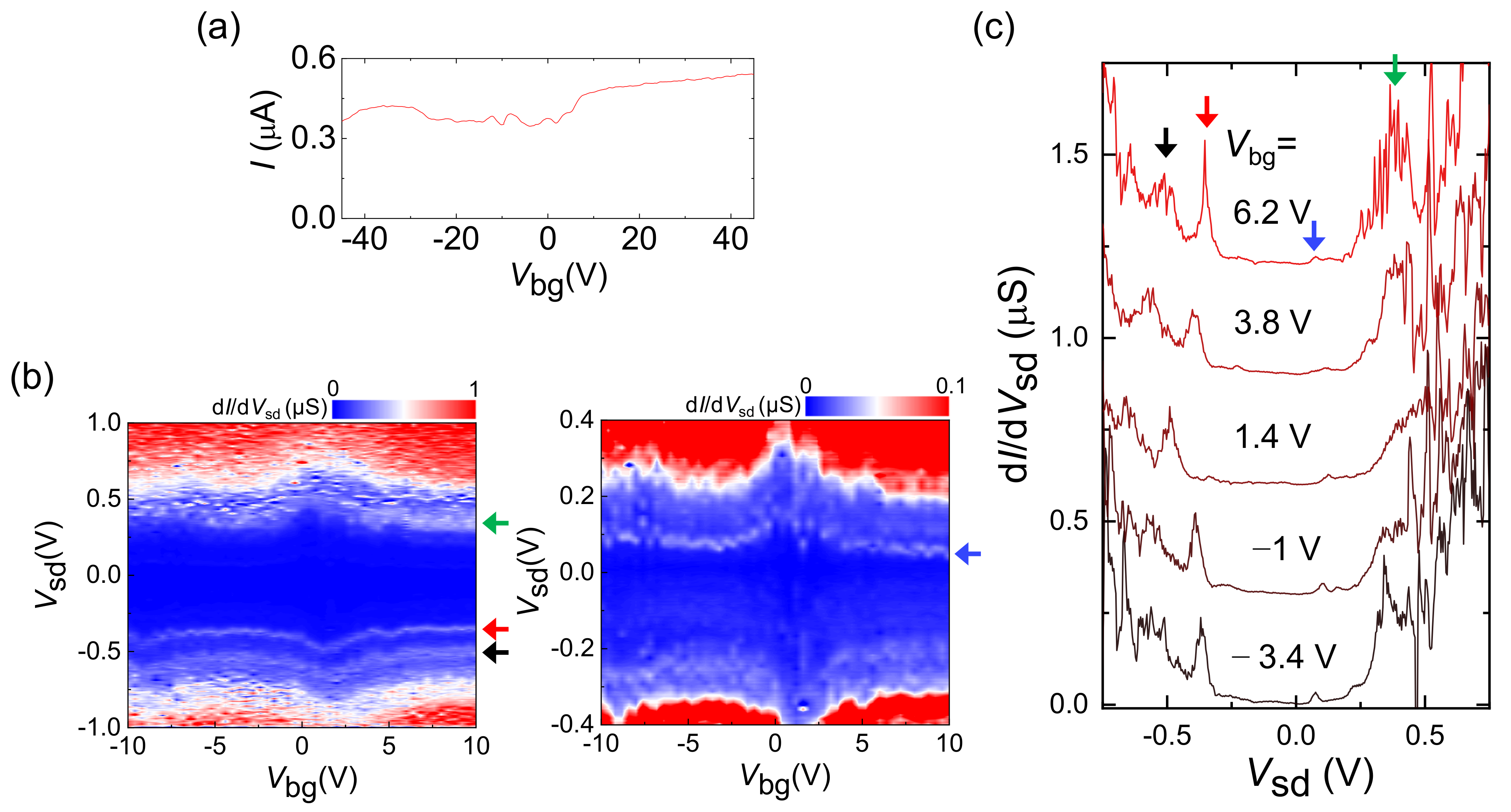Tunneling Spectroscopy for Electronic Bands in Multi-Walled Carbon Nanotubes with Van Der Waals Gap
Abstract
1. Introduction
2. Results and Discussion
2.1. vdW Gap Tunneling Spectroscopy
2.2. Characterization of DWCNT
2.3. vdW Tunneling Spectroscopy for DWCNT
2.4. Band Model for sm-DWCNT Tunnel Junction
2.5. Density Functional Theory (DFT) Calculations for DWCNTs
2.6. vdW Tunneling Spectroscopy for MWCNTs
3. Materials and Methods
3.1. Growth of MWCNT
3.2. Theoretical Calculations
3.3. Raman and AFM Characterization
3.4. Experiments
4. Conclusions
Supplementary Materials
Author Contributions
Funding
Data Availability Statement
Conflicts of Interest
Sample Availability
References
- Liu, Y.; Guo, J.; Zhu, E.; Liao, L.; Lee, S.-J.; Ding, M.; Shakir, I.; Gambin, V.; Huang, Y.; Duan, X. Approaching the Schottky–Mott limit in van der Waals metal–semiconductor junctions. Nature 2018, 557, 696–700. [Google Scholar] [CrossRef]
- Wang, Y.; Kim, J.C.; Wu, R.J.; Martinez, J.; Song, X.; Yang, J.; Zhao, F.; Mkhoyan, A.; Jeong, H.Y.; Chhowalla, M. Van der Waals contacts between three-dimensional metals and two-dimensional semiconductors. Nature 2019, 568, 70–74. [Google Scholar] [CrossRef]
- Kim, B.-K.; Kim, T.-H.; Choi, D.-H.; Kim, H.; Watanabe, K.; Taniguchi, T.; Rho, H.; Kim, J.-J.; Kim, Y.-H.; Bae, M.-H. Origins of genuine Ohmic van der Waals contact between indium and MoS2. NPJ 2D Mater. Appl. 2021, 5, 9. [Google Scholar] [CrossRef]
- Lau, C.S.; Chee, J.Y.; Ang, Y.S.; Tong, S.W.; Cao, L.; Ooi, Z.-E.; Wang, T.; Ang, L.K.; Wang, Y.; Chhowalla, M.; et al. Quantum transport in two-dimensional WS2 with high-efficiency carrier injection through indium alloy contacts. ACS Nano 2020, 14, 13700–13708. [Google Scholar] [CrossRef]
- Zhao, Q.; Jie, W.; Wang, T.; Castellanos-Gomez, A.; Frisenda, R. InSe Schottky diodes based on van der Waals contacts. Adv. Funct. Mater. 2020, 30, 2001307. [Google Scholar] [CrossRef]
- Choi, D.-H.; Jang, S.; Jeong, D.-W.; Lee, J.-O.; Chang, H.; Ha, D.-H.; Lee, S.M.; Kim, J.; Suh, Y.D.; Bae, M.-H.; et al. Van-der-Waals-gap tunneling spectroscopy for single-wall carbon nanotubes. Carbon 2017, 113, 237–242. [Google Scholar] [CrossRef]
- Murakami, T.; Matsumoto, K.; Kisoda, K.; Naito, R.; Nishio, K.; Isshiki, T.; Harima, H. Studies on the growth of pure double-walled carbon nanotube and its phonon spectra. J. Appl. Phys. 2008, 103, 114305. [Google Scholar] [CrossRef]
- Appenzeller, J.; Knoch, J.; Radosavljević, M.; Avouris, P. Multimode transport in Schottky-barrier carbon-nanotube field-effect transistors. Phys. Rev. Lett. 2004, 92, 226802. [Google Scholar] [CrossRef] [PubMed]
- Moon, S.; Song, W.; Lee, J.S.; Kim, N.; Kim, J.; Lee, S.-G.; Choi, M.-S. Eightfold shell filling in a double-wall carbon nanotube quantum dot. Phys. Rev. Lett. 2007, 99, 176804. [Google Scholar] [CrossRef] [PubMed]
- Giusca, C.E.; Tison, Y.; Silva, S.R.P. Inter-layer interaction in double-walled carbon nanotubes evidenced by scanning tunneling microscopy and spectroscopy. Nano 2008, 3, 65–73. [Google Scholar] [CrossRef]
- Soto, M.; Boyer, T.A.; Biradar, S.; Ge, L.; Vajtai, R.; Elías-Zúñiga, A.; Ajayan, P.M.; Barrera, E.V. Effect of interwall interaction on the electronic structure of double-walled carbon nanotubes. Nanotechnology 2015, 26, 165201. [Google Scholar] [CrossRef]
- Blase, X.; Benedict, L.X.; Shirley, E.L.; Louie, S.G. Hybridization effects and metallicity in small radius carbon nanotubes. Phys. Rev. Lett. 1994, 72, 1878–1881. [Google Scholar] [CrossRef]
- Qin, C.; Tian, Z.; Luo, X.; Xie, Q.; Nie, T.; Guo, X. First-principles study of electronic structure of double-walled and single-walled carbon nanotubes. Ceram. Int. 2021, 47, 2665–2671. [Google Scholar] [CrossRef]
- Kim, B.-K.; Ahn, Y.-H.; Kim, J.-J.; Choi, M.-S.; Bae, M.-H.; Kang, K.; Lim, J.S.; López, R.; Kim, N. Transport measurement of Andreev bound states in a Kondo-correlated quantum dot. Phys. Rev. Lett. 2013, 110, 076803. [Google Scholar] [CrossRef] [PubMed]
- Biercuk, M.J.; Mason, N.; Martin, J.; Yacoby, A.; Marcus, C.M. Anomalous conductance quantization in carbon nanotubes. Phys. Rev. Lett. 2005, 94, 026801. [Google Scholar] [CrossRef] [PubMed]
- Delley, B. An all-electron numerical method for solving the local density functional for polyatomic molecules. J. Chem. Phys. 1990, 92, 508–517. [Google Scholar] [CrossRef]
- Tkatchenko, A.; Scheffler, M. Accurate molecular van der Waals interactions from ground-state electron density and free-atom reference data. Phys. Rev. Lett. 2009, 102, 073005. [Google Scholar] [CrossRef]
- Perdew, J.P.; Burke, K.; Ernzerhof, M. Generalized gradient approximation made simple. Phys. Rev. Lett. 1996, 77, 3865–3868. [Google Scholar] [CrossRef]
- Wilder, J.W.G.; Venema, L.C.; Rinzler, A.G.; Smalley, R.E.; Dekker, C. Electronic structure of atomically resolved carbon nanotubes. Nature 1998, 391, 59–62. [Google Scholar] [CrossRef]
- Odom, T.W.; Huang, J.-L.; Kim, P.; Lieber, C.M. Atomic structure and electronic properties of single-walled carbon nanotubes. Nature 1998, 391, 62–64. [Google Scholar] [CrossRef]
- Zhao, S.; Yoo, S.; Wang, S.; Lyu, B.; Kahn, S.; Wu, F.; Zhao, Z.; Cui, D.; Zhao, W.; Yoon, Y.; et al. Tunneling spectroscopy in carbon nanotube-hexagonal boron nitride-carbon nanotube heterojunctions. Nano Lett. 2020, 20, 6712–6718. [Google Scholar] [CrossRef] [PubMed]






| Chirality | (8, 0) | (9, 0) | (10, 0) | (17, 0) | (18, 0) |
|---|---|---|---|---|---|
| Diameter (Å) | 6.26 | 7.05 | 7.83 | 13.32 | 14.10 |
| Eg (eV) | 0.55 | 0.10 | 0.91 | 0.54 | 0.02 |
| Property | sm | (m) | sm | sm | (m) |
| Chirality | (8, 0)@(17, 0) | (9, 0)@(17, 0) | (10, 0)@(18, 0) | (9, 0)@(18, 0) |
|---|---|---|---|---|
| Component Property | sm@sm | m@sm | sm@m | m@m |
| Eg (eV) | 0.47 | 0.22 | 0.03 | 0.02 |
| DWCNT property | sm | sm | (m) | (m) |
Publisher’s Note: MDPI stays neutral with regard to jurisdictional claims in published maps and institutional affiliations. |
© 2021 by the authors. Licensee MDPI, Basel, Switzerland. This article is an open access article distributed under the terms and conditions of the Creative Commons Attribution (CC BY) license (https://creativecommons.org/licenses/by/4.0/).
Share and Cite
Choi, D.-H.; Lee, S.M.; Jeong, D.-W.; Lee, J.-O.; Ha, D.H.; Bae, M.-H.; Kim, J.-J. Tunneling Spectroscopy for Electronic Bands in Multi-Walled Carbon Nanotubes with Van Der Waals Gap. Molecules 2021, 26, 2128. https://doi.org/10.3390/molecules26082128
Choi D-H, Lee SM, Jeong D-W, Lee J-O, Ha DH, Bae M-H, Kim J-J. Tunneling Spectroscopy for Electronic Bands in Multi-Walled Carbon Nanotubes with Van Der Waals Gap. Molecules. 2021; 26(8):2128. https://doi.org/10.3390/molecules26082128
Chicago/Turabian StyleChoi, Dong-Hwan, Seung Mi Lee, Du-Won Jeong, Jeong-O Lee, Dong Han Ha, Myung-Ho Bae, and Ju-Jin Kim. 2021. "Tunneling Spectroscopy for Electronic Bands in Multi-Walled Carbon Nanotubes with Van Der Waals Gap" Molecules 26, no. 8: 2128. https://doi.org/10.3390/molecules26082128
APA StyleChoi, D.-H., Lee, S. M., Jeong, D.-W., Lee, J.-O., Ha, D. H., Bae, M.-H., & Kim, J.-J. (2021). Tunneling Spectroscopy for Electronic Bands in Multi-Walled Carbon Nanotubes with Van Der Waals Gap. Molecules, 26(8), 2128. https://doi.org/10.3390/molecules26082128






